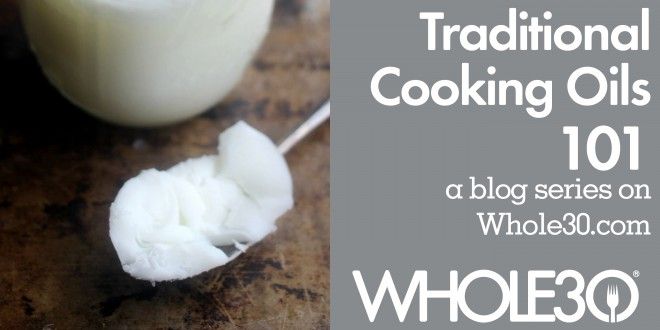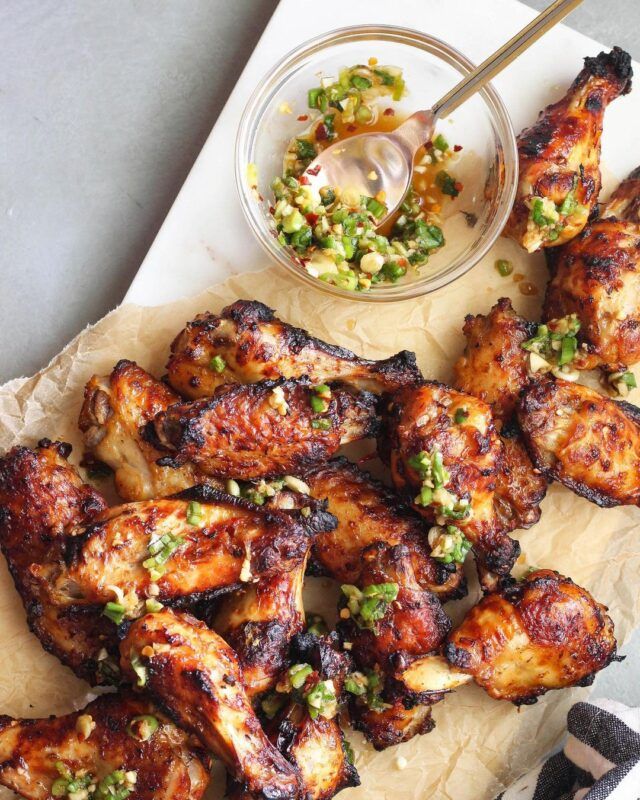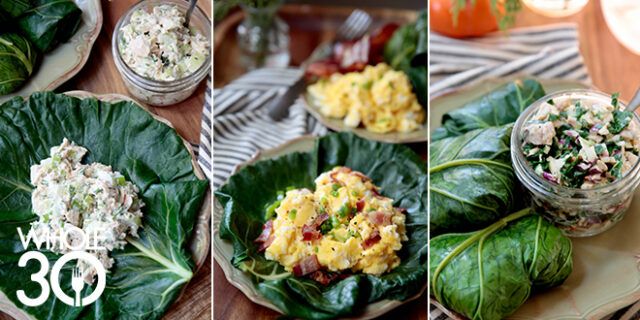This post is part of our Traditional Cooking Oils 101 series. To learn more about eating and cooking with animal oil, click here.
Welcome back to the final post in our Traditional Cooking Oils 101 series with Whole30 Approved partner Fatworks. Fat aficionado Bob Bernotsky agreed to share few more of his favorite recipes using Duck Fat and Chicken Schmaltz. And, he’s letting us in on a secret—by straining his animal fats, he saves money and gets twice the life out of one jar.
Are you inspired to experiment with animal oils after all of this fat education? Don’t miss the exclusive offer from Fatworks at the end of this post.
Straining Your Fatworks Oils
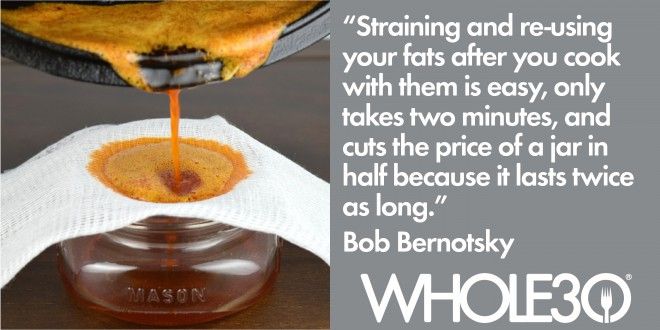
From Bob: If you love the flavors of animal fats as much as I do, then you’ll want to stretch your jars out as long as possible. The way to do this is by straining and re-using your fats after you cook with them. It’s easy, it only takes two minutes, and it cuts the price of a jar in half because it lasts twice as long.
Here’s how:
- Once you’re done cooking a meal in a skillet or pan, remove the it from the burner so that the pan cools down a bit.
- Stretch a piece of doubled-up cheesecloth over the mouth of a glass jar. (Coffee filters without seams work well, too.)
- While the pan is still hot (but not burn-your-fingers-hot), slowly pour the fat from the pan into the mason jar. That’s it! The good stuff filters through the cheese cloth and the food particles get left behind. Now your fat is ready for round two.
- Store your filtered fat in the refrigerator until you’re ready to use it again.
There’s a bit of an art behind stretching out the life of a jar of animal oil. Here’s what I do:
- The first time or two I use an animal fat, I’ll use it to sear meat. For example, I’ll crack open a fresh jar of Duck Fat to sear a big rib eye steak. I toss a couple tablespoons of fat into a cast iron skillet to make sure the steak is knee-deep in fat while searing. Once the meat is done cooking, I strain the leftover fat into a jar and keep it in the fridge.
- From there, I’ll use the strained fat to cook recipes that call for less cooking oil, like veggie dishes. Re-used fats take on the flavors of the spices you previously cooked with, which brings amazing flavor dimension to your vegetables.
If you’re thinking to yourself, “Wow! I’ve wasted a lot of money by not straining my fats all this time,” you’re one hundred percent right! But, you can’t cry over spilled milk – or lost fat, in this case. Just grab some cheesecloth or coffee filters the next time you’re at the grocery store and start stretching your Whole30 dollars!
Hey, while we have rib eye steak fresh on the mind…
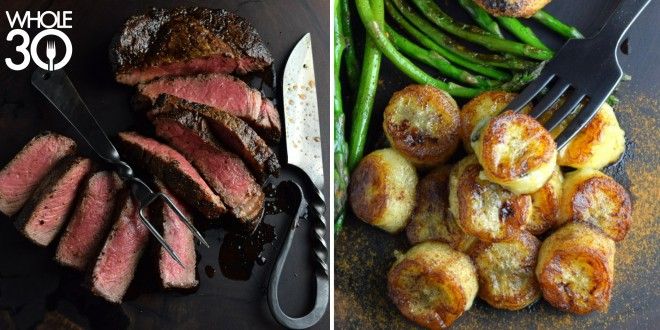
Duck Fat Rib Eye
Everybody knows how delicious rib eye steaks are. But when you sear a rib eye in duck fat in a cast iron pan, you take delicious to a whole new level. And unlike grilling, you don’t have to rely on Mother Nature to cooperate with you. This method starts on your stove top and finishes in your oven.
Ingredients
- Rib eye steak (about 1.25″ thick)
- 1.5 Tablespoon Fatworks Duck Fat
- Sea salt
- Black pepper
- Your favorite spice blend (try Whole30 Approved Primal Palate spice Meat and Potatoes blend or the Mocha Steak Rub on page 279 of It Starts With Food)
Instructions
RUB the steak generously on both sides with sea salt, then your favorite spice blend. Set aside and let it sit on the counter while the oven and skillet are preheating.
PREHEAT your oven to 375 and preheat a cast iron skillet on the stove in between medium and medium high. If you don’t have a cast iron skillet, make sure you use an oven safe skillet.
ONCE the skillet is hot, add the duck fat and let it heat up for a minute or two.
PLACE the steak in the skillet and set a timer for 60 seconds. Flip the steak and sear the other side for 60 seconds.
PLACE the skillet into the preheated oven. Roast for 5 to 6 minutes to yield a rare or medium rare finish.
REMOVE the steak from the skillet, put it on a plate and tent lightly with aluminum foil. Let it sit for 4 minutes before serving.
Recipe Note: Never use a fork when handling a steak. You don’t want to puncture the steak and lose juices. Use tongs instead.
Schweet Banana Schmaltz
Looking for tasty way to use those bananas on your counter before they go bad? When you start to see brown spots on them, the stage is set for Schweet Banana Schmaltz. Serve as a side with any protein and vegetable to add a tasty dimension to any meal. (Bob likes to serve it with a crispy roasted chicken thigh and asparagus.)
Ingredients
- 1 large brown spotted banana
- 2 teaspoons Fatworks Chicken Schmaltz
- Pinch of sea salt
- Pinch of cinnamon
Instructions
TOSS 2 teaspoons of Chicken Schmaltz in a skillet and set the heat on medium. Peel the banana and slice it into 3/4″ rounds while your skillet is heating up.
ONCE the skillet is hot, place the banana rounds in the pan (flat side down) and dust them with a little sea salt.
COOK for approximately 4 minutes, flip with tongs, and cook for another 4 min. Remove the bananas from the skillet when they’re browned and soft. Dust with cinnamon and serve hot.
Take 20% off All Fatworks Oils
Between now and May 7th, take 20% your Fatworks purchase with the code WholeFat. (The Duck Fat that Bob uses in his rib eye recipe is currently out of stock, but it will be available again starting on May 1.) Click here to shop all Fatworks products.

Bob Bernotsky of Simply That Paleo Guy is a Paleo foodie, fitness enthusiast, and lover of the outdoors. Connect with Bob: Blog | Instagram.

